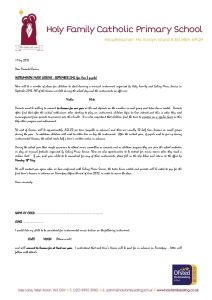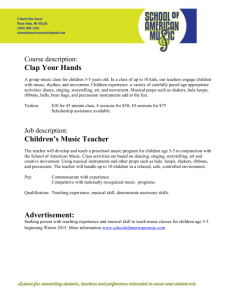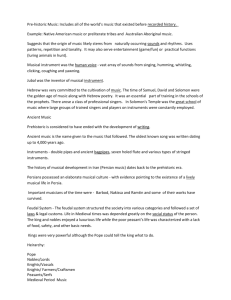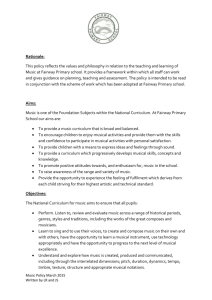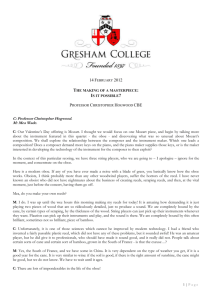Sound, Music or Noise Lesson Plan
advertisement
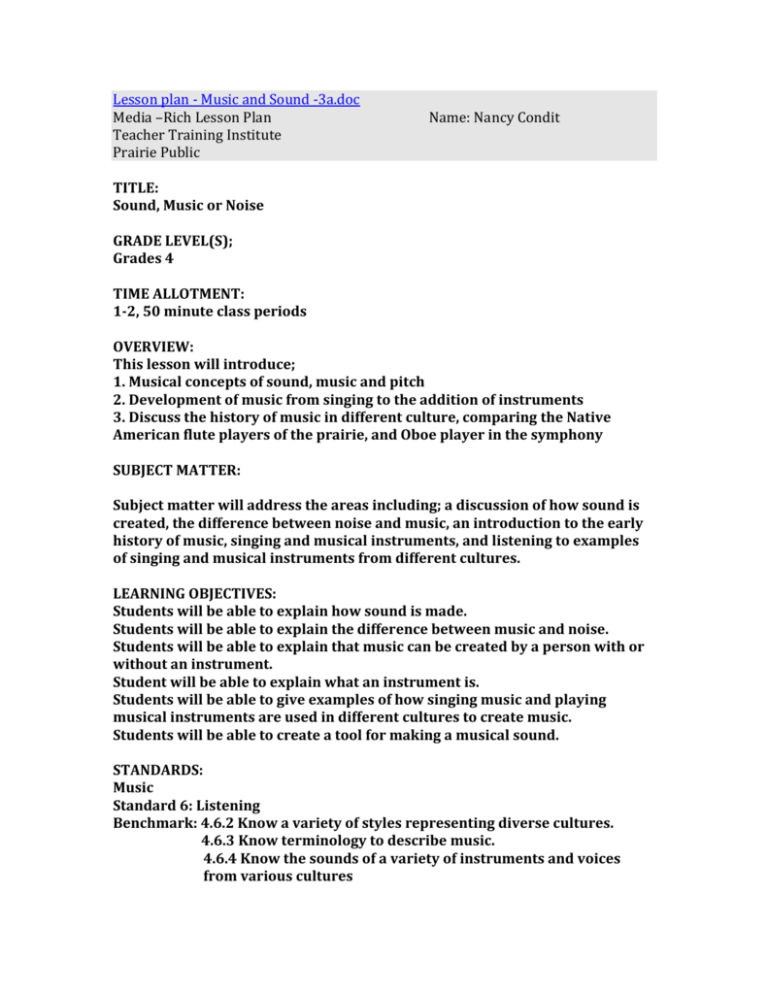
Lesson plan - Music and Sound -3a.doc Media –Rich Lesson Plan Teacher Training Institute Prairie Public Name: Nancy Condit TITLE: Sound, Music or Noise GRADE LEVEL(S); Grades 4 TIME ALLOTMENT: 1-2, 50 minute class periods OVERVIEW: This lesson will introduce; 1. Musical concepts of sound, music and pitch 2. Development of music from singing to the addition of instruments 3. Discuss the history of music in different culture, comparing the Native American flute players of the prairie, and Oboe player in the symphony SUBJECT MATTER: Subject matter will address the areas including; a discussion of how sound is created, the difference between noise and music, an introduction to the early history of music, singing and musical instruments, and listening to examples of singing and musical instruments from different cultures. LEARNING OBJECTIVES: Students will be able to explain how sound is made. Students will be able to explain the difference between music and noise. Students will be able to explain that music can be created by a person with or without an instrument. Student will be able to explain what an instrument is. Students will be able to give examples of how singing music and playing musical instruments are used in different cultures to create music. Students will be able to create a tool for making a musical sound. STANDARDS: Music Standard 6: Listening Benchmark: 4.6.2 Know a variety of styles representing diverse cultures. 4.6.3 Know terminology to describe music. 4.6.4 Know the sounds of a variety of instruments and voices from various cultures Standard 8: Music and other disciplines. Benchmark: 4.8.2 – Understand the interrelationship of music and other disciplines. Standard 9: Music History and Culture Benchmark: 4.95 – Understand the role of musicians in various musical settings. Science Standard 3: Students understand the basic concepts and principles of physical science. Benchmark: 4.3.6 – Explain how the pitch of a sound is related to the rate of vibration. MEDIA COMPONENTS – VIDEO AND/OR WEB: video http://www.ndstudies.org/media/prairie_artists_keith_bear_morning_star_whisper http://www.ndstudies.org/media/musical_concepts_oboe http://www.ehow.com/how_7704540_make-instrument-sound-scienceproject.html MATERIALS NEEDED: Drinking straws Scissors Ruler PREP FOR TEACHERS: Bookmark website for resources if necessary Gather supplies Make samples of instrument Prepare questions to be answered during the video – samples included with attachment INTRODUCTORY ACTIVITY - SETTING THE STAGE : Attention getter – When you are out on the playground playing and everyone is laughing, shouting, and talking to each other, would your teacher think you were making noise or music? (noise) Music is said to be organized sound, while noise is unorganized sound. Music is made up of sound that has a specific set of pitches and rhythmic patterns. Noise is usually many sounds happening at the same time without any particular order. Whisper to your neighbor and come up with as many places you can think of that people make noise. (Cheering at a basketball game). After 2 minutes I want each set of partners to tell me one of their ideas without repeating what is already been said, we will make a list on the board. (Brainstorm, Put up two headings - noise, music) Now how many of you remember the alphabet song you learned in kindergarten or 1st grade? Let’s sing it together. (A B C D etc.) What kind of sound are you making now? (Singing or making music). Even this simple song you learned long ago has a basic pattern of rhythm and pitches. When rhythm and pitch form a specific pattern it is music. Once again for two minutes in a whisper visit with your neighbor and list all the places, we hear music. (Brainstorm and list on the board under music). i.e. church. Music is all around us. You just made a list of places and thing that give us music. We hear music on TV, computer games, iPods and phones. We hear music in stores or dentist offices etc. or anywhere you may have to wait for something to take place. We can go to concerts or buy CD’s. Music is a very important part of our lives. Today we are going to explore sound through music. We will see how music has been around a long time and has become intertwined with everything we do no matter where we are or where we come from. Activity 1. Take a sheet of paper out and we will take a few notes as we go along. Vocabulary words to listen for: Sound (a type of energy made by vibrations) Vibrate (when something disturbs the air, that movement is called vibration) Sound waves (Vibration disturbs the air creating sound waves which move away from the disturbance until the energy is gone) Noise (unorganized sound) Music (organized sound) Singing (musical sound created by a person pushing air through their vocal chords) Musical Instrument (a tool for creating music by striking, strumming or blowing into or over an opening – a bottle or a tube) 1. *What is sound? Sound is a type of energy made by vibrations. I have a tuning fork used to tune pianos. When I tap the tuning fork what happens (Hit the tuning fork on your hand or table top.) This movement is called a vibration. These vibrations disturb the air creating sound waves, which keep going until they run out of energy. If your ear is within the range of those sound waves, you hear sound. (Have students clap their hands three times) When I asked you to clap your hands, what happened? (You disturbed the air causing it to vibrate and that movement created sound waves. Can we see the sound waves? (no) but we can hear them. If we make irregular sound waves which become unorganized sound, they are considered noise. (Make a motion in the air with your hand going up and down in a random way or make a drawing on the board of waves that are close together and far apart, in other words, random)i.e. ll lll l llll ll lllllll If those waves are regular repeated or organized waves, you hear musical sounds. (Make a large motion with your hand in an even up and down movement gradually making the motion smaller and smaller or draw on the board a very even pattern going up and down and gradually getting smaller). i.e. llll llll llll llll 2. * How do we hear these sounds? (When air waves vibrate against your ear drum) Sound is heard when the vibration of air waves hit your ear drum. Our ear drum is so sensitive, we can even hear someone whispering. We have just been whispering to each other. You could hear the person next to you even though I couldn’t hear what you were each saying because I wasn’t close enough. If we talk in an indoor voice, we can hear within the classroom. If we use our outdoor voices, we can be heard from a great distance. Music can also be loud or soft, but is much more pleasant to listen to than noise. Turn to your partner and in a whisper share five places you have heard music. After 2 minutes we will list on the board under our music column different places we hear music. By using our list on the board, let’s think about how the music was performed. Whisper to your partner again and try to come up with three ways the music we listed above was performed. (Singing, guitars, drums band etc.) 3.*Looking at our list of types of music let’s figure out how the music was made. Music is created by people using their body for making sound or by adding a tool called an instrument to make sound. So music can be made by people alone or with the help of an instrument. 4.*How do people make music? (By using various parts of their body) People make music by pushing air over their vocal chords, pushing air between their lips, or clapping their hands or stomping their feet. Singing usually has words but singing can happen by just singing vowels like ah or oh. Air being blown between the lips is usually considered to be humming or whistling. So people can make music just by using their bodies. Some historians believe that people made a crude type of music with their voices before they even talked. Mothers hummed to their babies, while whistling was used to warn others that someone was coming. Imagine what that would be like a long time ago before cell phones and other technology. Over time people wanted to create music with more than just their bodies. So they started hitting something with a stick in a rhythmic pattern. The drum was born. Someone discovered you could stretch strings across a hollow bowl and strum them their fingers. Thus a lute or guitar-like instrument came into being. Someone tried blowing through a hollow reed and the recorder and oboe were born. Gradually many types of instruments were made. 6.*So what is an instrument? An instrument can be something that creates sound by hitting something or being beat like a drum, by strumming something with strings like a guitar or by being something you can blow on or into like a recorder or oboe. They all sound different from each other but are still considered to be a musical instrument. 7.*What makes sounds different from each other? (Pitch - the speed at which the vibrations are causing the air waves to travel creates different pitches) Our ear drum is so sensitive we can hear different pitches based on how fast the sound waves are traveling. High pitches are created by very rapidly moving vibrations or sound waves, while very low pitches are created by slower vibrations or sound waves. Even two people talking have different pitches which makes it possible for us to recognize one person’s voice from another. Animals make sounds that are different pitches as well. Birds are very high and bears have a very low and loud sound. Because birds or other animals create different sounds, when we hear instruments that sound like animals, we think of when we were around them. Sometimes music is used to help us create a feeling of being somewhere special or make us think of a different place or time. An example of this idea is in the video we are going to watch. One of the early instruments used by Native Americans here in North Dakota was a type of flute or what was called a flageolet made out of a reed or hollow piece of wood. I want you to listen to an example of this type of musical instrument used by Keith Bear. He shows us an example of both singing and playing an instrument. Learning activity: Number I Video clip No. 1, Keith Bear Materials: Questions to be answered from the video. Hand out questions: Write down the answers to the following questions as you discover them in the video. (The questionnaire attachment has these questions without the answers.) 1. Is Keith Bear singing or playing an instrument at the beginning of the video? (He is playing an instrument) 2. Describe the flute? Is he blowing into it, hitting it or strumming it. (He is blowing into the flute) 3. Is the pitch high or low? (High) 4. What can we guess about the speed of the vibrations hitting our ear drum? Are they fast or slow? ( The speed of the vibrations are very fast). Watch the video and discuss. Let’s listen to another example of a musical instrument. Learning Activity Number II (Possibly day 2) (If this is day two review the discussion from the day before.) Video no. 2 – The oboe Discussion: The flute played by Keith Bear was used to help us feel like we were out in the open spaces by a river where we could hear birds and feel unhurried. It was relaxing and quiet. The next type of instrument is being played by Jennifer Peterson, who is also blowing into an instrument, but we will notice it has a different sound. It will make us think of something different. Hand out the worksheet with questions about the next video. 1. What does the first melody she plays sound like? (A snake charmer playing to a snake in a basket. Because of the sound the snake rises out of the basket and moves back and forth to the sound.) 2. What pitch or note does the oboe play for the orchestra? (The Oboe plays an A which is considered a central pitch that all the instruments tune their instruments to before starting to play a piece of music.) 3. What is the shape of an Oboe? (The oboe is conical in shape which is like a triangle. It is narrow at the top and wider at the bottom.) 4. Name one kind of wood the oboe is made from? (Oboes are generally made from Granadilla wood found in Africa, or violet wood and snake wood found in Europe.) 5. How is the reed for the oboe made? (Reeds for an oboe are usually made from cane.) What are some differences between the two videos? (1.The Native American flute is often played alone where the oboe is usually part of an orchestra. 2. The flute originated with the Native Americans so is probably much older than the oboe which is traced back to the early 17 hundreds. 3. The flute doesn’t have a double reed like the oboe has. 4. The setting for the performing of these two instruments is very different. The Oboe will probably be found in a concert hall, while the flute might be played outside in a nature-like setting. Both are great instruments.) Can we make an instrument? Let’s try. CULMINATING ACTIVITY: The students will make a reed type instrument from a plastic straw. MATERIALS: 1. Pass out a straw for each student. 2. Pinch one end of the straw together 3. With a scissor cut a v shape at the pinched end through both sides of the straw. 4. The straw may be cut at various lengths to change the pitches. 5. If you wanted to have somewhat of a scale of sound, leave one straw full length and cut a half inch off the next straw and then 1 1/2 inches off the next etc. CROSS-CURRICULAR ACTIVITY: MATERIALS: Draw a picture or write a story explaining one of the things listed below. Explain one of the following: 1. How is sound, vibration and pitch made? 2. Explain about music being organized sound. 3. Explain about the two cultural examples of music being played by a type of flute and by an oboe. 4. Explain about how pitch can be determined by the length of the straw or instrument. COMMUNITY CONNECTIONS: Invite the students to attend a musical concert in the community. Bring in an announcement from the newspaper or a poster or a ticket of a concert in the community. Remind them to think about how the sound is made, what type of music is being performed, what instruments are being used and whether the music is something they have heard before or is new to them. STUDENT MATERIALS: Handout sheets Straws Scissors

